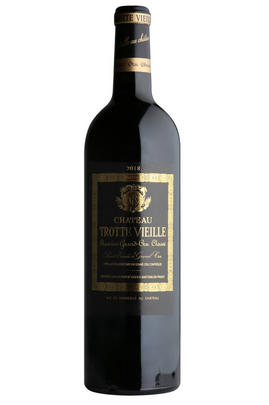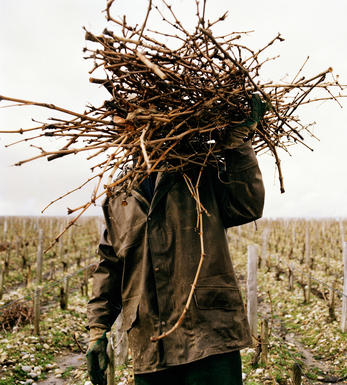
2009 Château Trotte Vieille, St Emilion, Bordeaux

Critics reviews
The 2009 Trotte Vieille has a very fine bouquet with a mixture of red and black fruit, chestnut and truffle developing in the glass and then hints of morels. The palate is mediumbodied with quite a sharp opening, spicy and vibrant with impressive attack before settling down towards a refined and quite persistent, hoisintinged finish. A fine, expressive Cabernet Franc here. Excellent. Tasted at BI Wines & Spirits' annual Ten Year On tasting.
Drink to 2035
Neal Martin, Vinous.com (March 2019)
Medium to deep garnet colored, the 2009 Trotte Vieille gives up notions of spice cake, potpourri and dusty soil with a core of prunes, chocolate-covered cherries and new leather. Medium to full-bodied, the palate has quite a chewy texture with a refreshing line cutting through the evolved, savory layers, finishing a little firm.
Lisa Perrotti-Brown, The Wine Advocate (March 2019)
Jancis Robinson MW, JancisRobinson.com (January 2013)
This rich red Bordeaux lives up to 2009’s image of opulence. Now fully developed with some caramel character wrapped around the solid tannic core. Long, robust finish. Drink or hold. (Horizontal Tasting, London, 2019)
James Suckling, JamesSuckling.com (March 2019)
Robert Parker, The Wine Advocate (February 2012)
The limestone location and extremely old-vine Cabernet Franc reticence are both on song here, making for an extremely appetising wine with the generosity and ripeness of the vintage, nicely balanced by the salinity of the plateau. There's a great interplay between freshness and power, and it steals up on you. A lovely example of St-Emilion and a great vintage at this property, showing well at 10 years old.
Drink to 2040
Jane Anson, (at BI Wine's 10 Years On Tasting, London), Decanter.com (February 2019)
About this WINE

Chateau Trotte Vieille
A 1er Grand Cru Classé (B) St. Emilion château which has been owned by the négociant house Borie-Manoux since 1949. The company also owns Château Batailley in Pauillac and Château Beau Site in St-Estèphe and is now run by Philippe Castéja. Trotte Vieille (the trotting old lady) refers to the legend of an old woman who lived here in the 18th century and spent her time trotting around in search of local gossip.
The property is located on a plateau east of St-Emilion and the 10-hectare walled vineyard is planted with Merlot (50%), Cabernet Franc (45%) and Cabernet Sauvignon (5%). The grapes are hand-harvested and then fermented in small, temperature-controlled concrete vats. The wine is matured in oak barriques (80% new) for 18 months. It is bottled unfiltered.

St Émilion
St Émilion is one of Bordeaux's largest producing appellations, producing more wine than Listrac, Moulis, St Estèphe, Pauillac, St Julien and Margaux put together. St Emilion has been producing wine for longer than the Médoc but its lack of accessibility to Bordeaux's port and market-restricted exports to mainland Europe meant the region initially did not enjoy the commercial success that funded the great châteaux of the Left Bank.
St Émilion itself is the prettiest of Bordeaux's wine towns, perched on top of the steep limestone slopes upon which many of the region's finest vineyards are situated. However, more than half of the appellation's vineyards lie on the plain between the town and the Dordogne River on sandy, alluvial soils with a sprinkling of gravel.
Further diversity is added by a small, complex gravel bed to the north-east of the region on the border with Pomerol. Atypically for St Émilion, this allows Cabernet Franc and, to a lesser extent, Cabernet Sauvignon to prosper and defines the personality of the great wines such as Ch. Cheval Blanc.
In the early 1990s there was an explosion of experimentation and evolution, leading to the rise of the garagistes, producers of deeply-concentrated wines made in very small quantities and offered at high prices. The appellation is also surrounded by four satellite appellations, Montagne, Lussac, Puisseguin and St. Georges, which enjoy a family similarity but not the complexity of the best wines.
St Émilion was first officially classified in 1954, and is the most meritocratic classification system in Bordeaux, as it is regularly amended. The most recent revision of the classification was in 2012

Cabernet Sauvignon Blend
Cabernet Sauvignon lends itself particularly well in blends with Merlot. This is actually the archetypal Bordeaux blend, though in different proportions in the sub-regions and sometimes topped up with Cabernet Franc, Malbec, and Petit Verdot.
In the Médoc and Graves the percentage of Cabernet Sauvignon in the blend can range from 95% (Mouton-Rothschild) to as low as 40%. It is particularly suited to the dry, warm, free- draining, gravel-rich soils and is responsible for the redolent cassis characteristics as well as the depth of colour, tannic structure and pronounced acidity of Médoc wines. However 100% Cabernet Sauvignon wines can be slightly hollow-tasting in the middle palate and Merlot with its generous, fleshy fruit flavours acts as a perfect foil by filling in this cavity.
In St-Emilion and Pomerol, the blends are Merlot dominated as Cabernet Sauvignon can struggle to ripen there - when it is included, it adds structure and body to the wine. Sassicaia is the most famous Bordeaux blend in Italy and has spawned many imitations, whereby the blend is now firmly established in the New World and particularly in California and Australia.


Buying options
Add to wishlist
Description
The 2009 Trotte Vieille has a very fine bouquet with a mixture of red and black fruit, chestnut and truffle developing in the glass and then hints of morels. The palate is mediumbodied with quite a sharp opening, spicy and vibrant with impressive attack before settling down towards a refined and quite persistent, hoisintinged finish. A fine, expressive Cabernet Franc here. Excellent. Tasted at BI Wines & Spirits' annual Ten Year On tasting.
Drink to 2035
Neal Martin, Vinous.com (March 2019)
wine at a glance
Delivery and quality guarantee